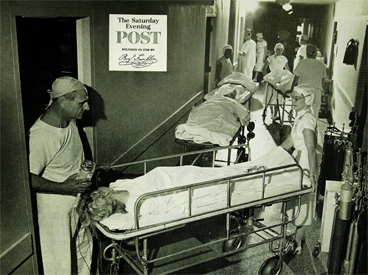In preliminary negotiations during the summer of 1955, labor leaders expressed interest in the plan—“I’d sure like to have that for my family,” one of them said—but they admitted it might not appeal to the rank-and-file membership.
“All right,” a G.E. spokesman proposed, “we’ll take the plan to all our employees, including those you represent. Then you can take a vote, local by local, of your membership to see if they want the new plan.”
“That seems fair,” a union negotiator agreed. “We won’t support you, but we won’t oppose you. We’ll leave it up to the men.”
The results of the vote were unbelievable. Almost 96 percent of the G.E. workers immediately voted in favor of the new plan—the proportion later rose to more than 99 percent—and by the end of last year, more than 750,000 employees and dependents were covered.
The employees soon learned how the new comprehensive program compared with the standard hospital-surgical insurance plan previously used at G.E. Typical was the case of a G.E. worker in Ohio whose two-year-old daughter was stricken by acute bronchitis, broncho-pneumonia, and brain complications. The child eventually recovered, but the bills seemed staggering.
“Her bills ran to $1,180,” her father said. “The old plan would have paid only $300. It wouldn’t have touched any of the $525 bill for medicines, which she needed at home. But the new plan paid us $967.”
In another case, an employee in New York suffered a severe heart attack, which kept him in a hospital for 84 days. His total bill was $6,291, including $2,027 for private nursing. Under the old standard plan, which did not cover private-duty nurses, he would have received $1,128. The new plan paid $4,783.
Another New York employee required prolonged treatment for a tumor of the spine, diabetes, and neuritis. His bill, including 75 days in a hospital, private nursing care, and a large expenditure for drugs and medicines used at home, ran to $9,906 over a two-year period. Under the old plan, which covered neither private nursing nor medicines for home use, he would have been paid $1,786. The new plan paid $7,205.
Equally important were the less dramatic but more frequent cases of employees with a multitude of small medical bills. One G.E. worker in California, for example, ran up a total of $410 for the costs of sickness during a year.
“I didn’t have a single serious illness,” he said. “No surgery, no hospitals. Just the usual little things. But they sure added up!”
Under the new plan, he received $320. Under the old plan, he would have received nothing.
By the end of the first full year of operation, the G.E. comprehensive plan had paid out more than $20 million in benefits. This was a remarkably large sum, but even more remarkable was the fact that it came out just about at the figure which the insurance statisticians had predicted.
“There had been relatively few abuses by anyone,” said Willis, “We trusted people, and they generally responded to that trust.”
At least partially responsible for that heart-warming record was the continuing use of every conceivable medium of information to explain every detail of the plan to the G.E. employees. “This is not just the company’s plan,” G.E. representatives told them. “It’s your plan too. It involves your dollars and your health. If it’s wrecked, we all lose.”
Similarly, in most of the areas in which a G.E. factory or office was located, local G.E. representatives met personally with the local physicians, pharmacists, and hospital administrators.
“All you people—doctors and hospital men and druggists—have a real stake in the success of our plan,” a company executive told a typical meeting in Louisville, Kentucky. “You’ve said you don’t like to work under a rigid fee schedule. Very well, we are not setting any fees. All we ask is that you keep your charges reasonable and normal, and for necessary services only. … Remember that it’s not some anonymous insurance company that pays your bills. It is General Electric and its employees who pay. … Our plan is still new, still in the testing stage. We sincerely and humbly ask that you help us make it succeed.”
After such a meeting in Erie, Pennsylvania, Dr. Elmer Hess, a past president of the AMA, spoke for many of his fellow doctors when he predicted that the medical profession was obliged to cooperate.
“There is no reason now to believe that the profession generally will do otherwise,” he said. “If it does not co-operate, then the profession will lose—and will deserve to lose—its battle for the preservation of private medical practice.”
Probably the highest tribute paid to the new General Electric comprehensive plan was the speed with which it was picked up by other employee groups and other insurance companies. Within little more than a year, similar programs were developed to cover 1,790 groups, including 1.4 million employees and dependents. By early this year, it was estimated that more than 100 insurance companies were writing a variety of comprehensive plans providing protection to more than 2 million people. Even one insurance official, who earlier denounced comprehensive health insurance as “actuarial anarchy,” recently listed it as one of the major insurance achievements of the decade.
Moreover, some labor leaders who once demanded state medicine as the only solution to the costs of medical care now admit that the new program may be meeting most of the needs.
“The development of this type of program,” wrote Joe Swire, health-insurance expert of the International Union of Electrical Workers, “is the insurance companies’ answer to the demand of American unions for national health insurance. It proves that the insurance industry is alert, aggressive and capable of coming up with some solid solutions to problems.” The solutions are not yet complete, he added, but they are “more perfect approaches” than any others that had been available.
Blue Cross and Blue Shield, which also had spurned comprehensive coverage, are now moving into the field. Sparked especially by the pioneering efforts of Wisconsin Physicians Service, these groups are beginning to offer a service-type comprehensive policy with no restrictive fee schedule, no limitations on family income, and free choice of physician.
“We told our doctors it’s their responsibility to see that the plan works,” says Charles Crownhart, of the State Medical Society of Wisconsin. “We’re going on the hunch that most people will be honest, if you tell them what’s involved. So far, we’ve been proved absolutely right.”
A few months ago, another significant program was launched when Blue Shield and Blue Cross in Connecticut joined with the Connecticut General Life Insurance Company to write an integrated policy providing comprehensive protection.
Although it seemed clear that comprehensive insurance would not necessarily be the best or the final answer to the financial problems of medical care, this form of protection has been hailed by some authorities as the most exciting development in the field since the start of Blue Cross nearly thirty years ago. Insurance experts approved it, since it still was a form of insurance. Many labor spokesmen—though certainly not all—approved it, since it was coming closer to their goal of complete prepayment or budgeting for the whole medical bill. Nevertheless, there were obvious gaps and loopholes. There were still opportunities for the dishonest doctor and the chiseling patient. Although, the new policies were relatively economical when sold to groups of workers, no one had yet figured how to make the protection available to individuals at a reasonable cost. No one had found how the new plans could solve the medical problems of the elderly. No one had found a completely acceptable method to provide prepayment for periodic health examinations and preventive medicine.
According to one of the nation’s foremost authorities on medical economics, however, the solution to these and similar problems no longer seems impossible.
“All of us in the field—labor, management, medicine, the Blues and the insurance companies—are experimenting more intensively than ever before,” says Dr. William Shepard, of Metropolitan. “The competition and the controversies are, in large measure, the signs of that research. So far, we have not met all the requirements for all the people, and maybe we never will meet them all. But we’re getting close.”
Become a Saturday Evening Post member and enjoy unlimited access. Subscribe now



